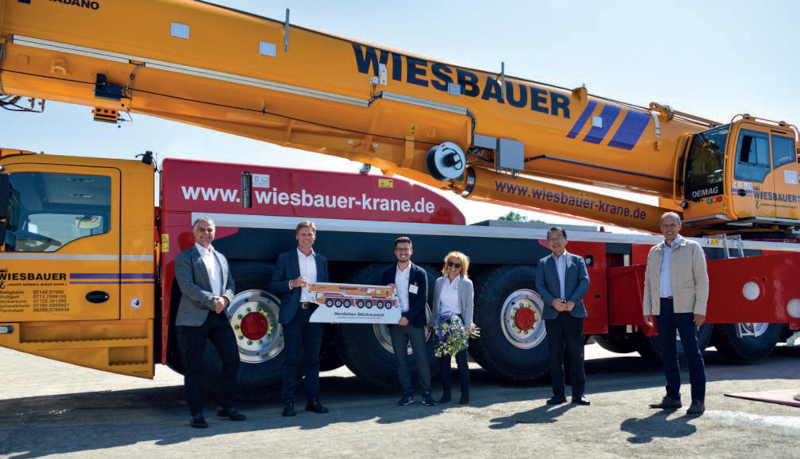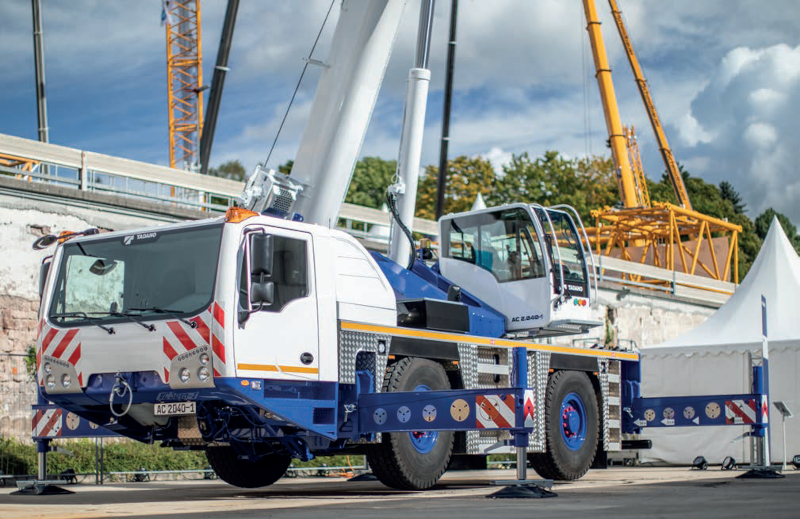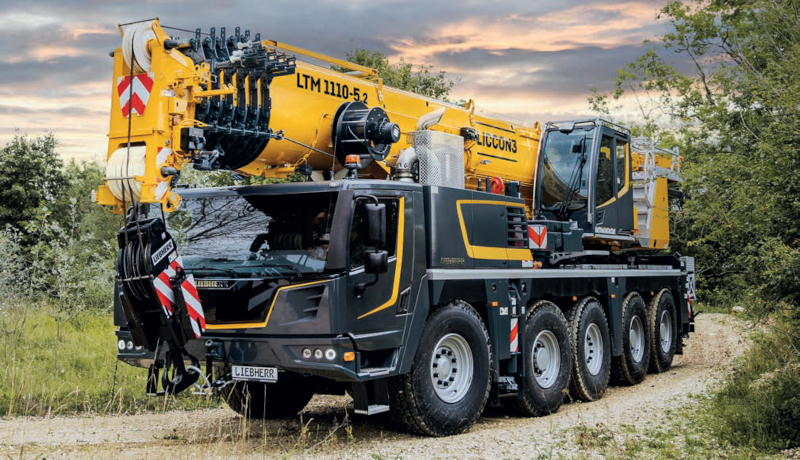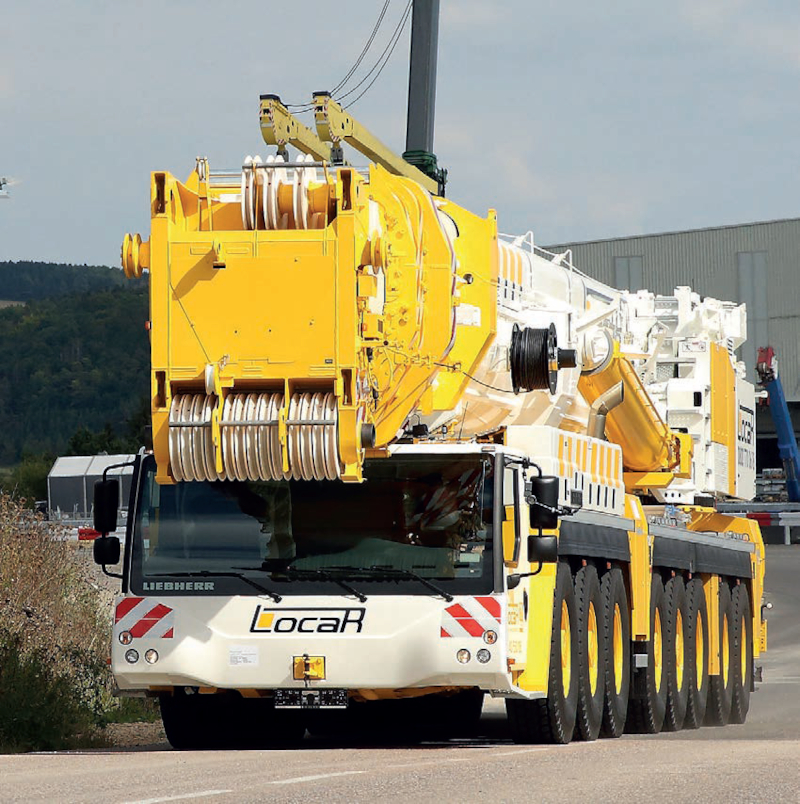All-terrains, the last and the first
21 January 2022Models and brand-names come; models and brand-names go... but all-terrains continue. Julian Champkin says hail and farewell.
The last Liebherr LTM 1500-8.1 all-terrain crane rolled off its Ehingen production line in November. It is a crane that has been in production for a remarkable 23 years. 626 of the eight-axle heavy-lift all-terrains have been made; and they have been exported all round the word – this last 1500-78.1 of them all is destined for a lifting contractor in Brazil.
Such a long production run says much about the versatility of the crane and the type, as well as about the quality of the original design and the advantages that all-terrain cranes in general offer. Liebherr are calling in the most successful large crane of all time.
It has had upgrades in that time, of course, and improvements; the ability to absorb improvements is one of the hallmarks of good design. Back in 1998, when it was being designed, the LTM 1500 had good things to offer – but perhaps not quite so good as they became.
Joachim Henkel was head of Liebherr’s structural engineering department at the time. “The variability of two telescopic booms, measuring 50 and 84 metres in length, was a unique selling point for the new crane,” he says. “But right at the start of the development work, we were not really very pleased with the lifting capacity values in telescope mode. The increase compared to the LTM 1400 that is was supposed to succeed was rather disappointing.”
Yggve Richter was part of his team. “At the time we were using a new calculation program which was significantly easier to use than the previous software package. Because of it, I was really motivated to do my absolute best. But I can remember something that our technical director, Dr. Hamme, said when I showed him the first tables at the time said, ‘Yes, but the lifting capacities are not exactly impressive …’ That sent me back to my desk to improve the whole thing again!”
Henkel again: “84 metres of boom at the time was a world record for a telescopic mobile crane! It was only possible because of the development of a new ovaloid boom concept. The LTM 1400 had a conventional rectangular cross-section with all sorts of buckling stiffeners in the boom to provide extra rigidity. But the stiffeners take up space and therefore prevent full retraction of telescopic sections into each other. The ovaloid cross-sections of the LTM 1500 needed almost no buckling stiffeners. And that meant we could build a six-section boom with this enormous boom length, which also had good rigidity, particularly sideways.”
600-odd sales of the crane mean that they got it right. 23 years later, as the 150-t capacity crane ends its unprecedented production run, Liebherr unveil a new version of their 110t-capacity all-terrain. Three completely new features, say Liebherr, distinguish the LTM 1110-5.2 from its 5.1 predecessor version.
Twenty three years back the LTM 1500 had an early version of LICCON. The new launch incorporates the third generation; it retains the time-tested control features but has a completely new software package and programming language as well as a faster databus, significantly more storage space and more computing power. “The current LICCON2 control system is reaching the limits of its capacity,” says Nikolaus Münch, Liebherr’s head of the control system department. “During the development of the new control system it was important to us that crane operators who are already familiar with Liebherr cranes would be able to get used to the new control system quickly and easily. At the same time, we must be future-proof as the progress currently being made in microelectronics is immense. Complex applications, such as our VarioBase, which require a great deal of performance data, can now be developed more frequently in the future.”
High synergy effects have encouraged Liebherr to introduce a new cab they have developed at the same time as they bring in the LICCON3 control system. A new multifunction steering wheel, side roller blind on the driver’s door, improved instruments and modules as well as new displays make life more pleasant for the operator. A sun sensor detects strong sunshine and automatically adjusts the heating settings; lighting for the cab, superstructure, headlights and jibs is now by LED.
The new DynamicPerform clutch module on the LTM 1110- 5.2 delivers almost zero wear starting and manoeuvring for the modular ZF TraXon gearbox, and without overheating. It transmits the engine power via an oilcooled plate pack that runs in oil. The friction heat generated when starting is dissipated in the clutch oil and supplied to the vehicle’s cooling system. This way permanent and almost wear-free manoeuvring is made possible, claims Liebherr. A clutch protection function prevents overheating of the clutch and the associated wear or destruction of the clutch under extreme load. Owners benefit from significantly extended service life of the drivetrain and drivers will have their workload reduced by the highly controllable clutch, Liebherr adds.
Another farewell in the all-terrain world is to the name of Demag. Tadano acquired Demag in 2019; in mid-October 2021 they announced that they would be sharing the same branding; the Demag name is now officially no more. The company has a new all-terrain, the first to be jointly developed by what used to be two separate teams, from Demag’s plant at Zweibrücken and Tadano’s at Lauf. It combines, therefore, the know-how of both German plants, and the expectation is that it will feature the best of both worlds.
The product is a two-axle 40t all terrain crane, the Tadano AC 2.040-1. It has a main boom of 35.2 metres and a maximum system length of 44.2 metres. Previewed in October, supply chain issues have delayed its launch slightly, to January/February 2022. With it Tadano introduced what they called the ‘joint DNA’ of their new all-terrain family. All new machines will feature common cabins, control systems, (The IC-1 Plus) and technologies, such as the Tadano Surround View system and IC-1 Remote telematics.
Meanwhile, undelayed, Tadano have delivered another first, its AC 7.450-1 all terrain crane to Wiesbauer – a company which has recently took over the cranes department of towing and recovery company Florian Herbold to become largest crane rental company in its region.
The crane features a series of advances that put it, say Tadano, at the top of its capacity class. Though it is on seven axles it still fits in the six-axle class in terms of its dimensions, with a carrier length of only 15.99 metres, an outrigger base of 8.49m, and a total length of 17.62m. It is a significantly more powerful option than all six-axle units that are currently available on the market, say Tadano, and even matches that of eight-axle cranes in a number of boom positions. It has an 80m boom; a patented luffing jib rigging system for particularly easy, fast, and safe setup; and a new SSL (Sideways Superlift) system in which the Superlift arms are mounted right at the front of the head, meaning that they are ultimately longer and provide larger lifting capacities.
And in July this year (2021) Tadano launched in Japan its 700t-capacity AR-7000N, which it says is the highest-lifting-capacity all terrain from a Japanese manufacturer. Its previous offering, the 550t AR-5500M, was also the largest all-terrain crane in the Japanese market when first introduced in 1998. It has long served large-scale infrastructure projects such as highways and bridge construction; as customers take on larger projects that require increases in capacity and efficiency, Tadano has responded with the AR-7000N, which comes on a seven-axle chassis – something that Tadano claims no other crane offers.
New materials and advanced design have given significant weight reduction and up to 40% improvement in performance, while still maintaining the same dimensions and weight as the AR-5500M. Lifting performance has been improved by up to 40% over that crane and is especially increased in the 20m working radius – which is popular in bridge construction. The boom performance has also been significantly improved, by between 10% and 40%; the crane has a new 43m four-stage ESP boom, replacing the three-stage boom of the AR-5500M. Since the four-stage version eliminates the need to assemble the conventional fixed boom when combined with the luffing jib, on many tasks this bypasses the need to secure assembly space and reduces assembly time.
A single cylinder extends and retracts the boom, making it lighter while improving capacity. When fixed boom and luffing jib are used the maximum ground lifting capacity is 140.5m, which greatly expands the working area. A six-stage ESP boom is also available that adds even more length.
The crane’s overall width is 3m and its height is just 4.3m. Maximum speed is 62.5 km/h.
Even with the six-stage boom installed, the AR-7000N has a shorter overall length than the AR-5500M at 18.82m. It has an outrigger installation width of 9.0m and a tail swing of 6.3m, all with a higher lifting capacity. This crane, too, comes with a newly-designed cab.
Asia is clearly an important market for all-terrains. Manitowoc have recently appointed a distributor for their Grove all-terrains in Japan, their first in that region, where the company is strengthening its operations. And, as with Tadano, it is producing variants specially designed for the Japanese market.
G Machinery, the new distributor, is based in Tokyo; shortly after coming on board it sold and delivered its first two cranes; one is a GMK5150L-1J, the other a GMK5250XL-1J. The “J” denomination reflects that their design is tailored specifically for Japan. Both were sold to a leading Japanese crane rental company. Shohei Konno, president of G Machinery, said the reputation and product quality of Grove cranes will make them an attractive option for customers in Japan.
G Machinery will offer the full range of Grove all-terrain cranes. It expects the six-axle and fiveaxle models to be particularly popular due to their load charts and manoeuvrability. The five-axle GMK5150L-1J is the most powerful crane in its category, with a capacity of 11.8t at the end of 60 metres of main boom which can be lifted out to a radius of up to 18 metres. The GMK5250XL-1J has a 78.5 metre boom – the longest in the five-axle class – with 250t capacity. Both cranes feature Grove’s Megatrak suspension and Manitowoc’s Twin- Lock boom pinning system.
New cabs for all-terrains seem to be universal just now. It is not entirely a coincidence: changing European crash-test regulations have been necessitating some changes, and manufacturers seem to have taken the opportunity to go for re-designs rather than make-overs. We have described Liebherr’s and Tadano’s contributions so we should mention Grove’s latest efforts as well. They based it on surveys of their customers and operators – and, more unusually and imaginatively, of their employees who actually build the cabs as well. They point out that crane operators not only drive from their cabs but also spend all day working from them as well, so ergonomics and small comforts become important. The prototype was shown at Bauma 2019, where visitors were asked to sit in it and their feedback was incorporated as well. One example of the company listening to these last suggestions was the addition of armrests to the driver’s seat to make long-distance driving more comfortable. The new carrier cab passed every stress test and also its crash-test at the first time of asking. This means it is now fully ECE R29-3 approved. The first units on three-axle carriers have recently been delivered; the versions for the five-axle and four-axle models will follow.



